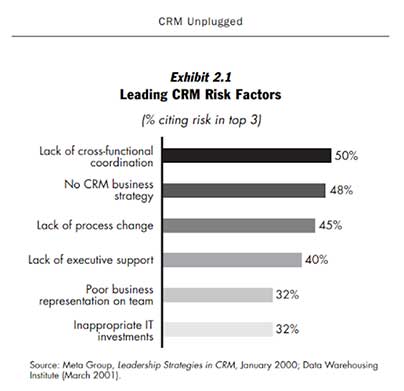Mitigating CRM Adoption woes
According to Buyerzone, almost 91% of companies with more than 11 employees utilize CRM. With the staggering amount of companies seeking to reap the benefits of having a CRM, the struggles of doing so have become more apparent. Various research shows that on average, one-third of CRM projects do not succeed, and this is due to many reasons, but one of the biggest contributors to its failure is the lack of CRM adoption.
CRM adoption has been the bane of CRM implementation for many, as most people will often resist change. When users don’t see the value of interacting with the software, they will use it less, which leads to low adoption rates. This results in a lack of customer information, sticking to manual data entry, poor insights, and a waste of investment.
Oftentimes, the problem is not the software itself, but the lack of proper implementation and strategy. Theoretically, we know that having a CRM modernizes and increases sales, it serves as a useful data platform for customer information. The challenge is translating those benefits into a reality for your company as well as understanding that a successful CRM implementation needs the involvement of active users.
We have summarized the most common CRM adoption woes or problems that companies face in regards to CRM adoption, and how to mitigate each one:
The chosen CRM software fails to add value
At the very start of it all, choosing the right CRM for your company is key. Subscribing to the trendiest or the most recommended software doesn’t always ensure success. Choose a CRM with features that can help solve specific problems and issues that your company is facing, as well as features that are relevant to the type of business or industry you are in.
As the ones mainly utilizing the software, also look at it through the lens of your users and assess each option.
- Do these features make it easier for them to use the software?
- Does this CRM eliminate inefficient procedures and optimize their workflow?
- Will the system give my employees a competitive advantage?
The CRM data entry software you choose should not be a mere formality or decoration, make sure that it adds value to your users’ work. People naturally use things that can benefit them. With value and functionality, usage of the software will eventually follow, thus increasing user adoption.
Inadequate communication
In connection to choosing the right CRM software, how will you know what the users’ problems are in the first place? Communication is a vital part of the process. Making decisions solely based on your perspective, without consulting your users, will result in mismatched interests, and that is just one example.
Studies show that the most prominent risk factor for CRMs is the “Lack of cross-functional coordination”, amounting to 50%. This implies that communication, amongst the users from each department, company executives, and CRM implementation supervisors, heavily affects the success of a CRM project.
Photo Taken from CRM Unplugged Ch 2, A review of CRM failures, p. 34
Communicating with your users is very important especially in the adoption stage. Involving them with decision-making processes such as the mitigation of current issues, choosing the right software, the creation of your company’s CRM training program, and so on, will help them better understand its value, giving them a sense of responsibility. They are not just being told to use an unfamiliar CRM software, but are actively involved in trying to utilize it for maximum efficiency. This not only applies in the early stages of adoption but throughout the entire duration of using the data entry software.
It is also important to communicate the company’s objectives and to have clearly defined goals. Let your users know about the goals of using a CRM. This could be to double lead conversion rates, or better organize customer data, etc. Actions and initiatives should be in line with your specific objectives and communicated to everyone to avoid irrelevant efforts in all sectors downstream.
CRM is implemented but not used
User resistance is a very common issue and might as well be the main cause of poor CRM adoption. It can be due to the following factors:
Poor usability
When the software is too complicated and inconvenient to access, it discourages employees from utilizing it daily and is difficult to adopt. Ease of use is an important factor because it reduces user resistance. If the users find the software easy to use as compared to their old methods, switching can be smoother.
Inconvenient Manual Data Entry
Users often complain about the amount of time and effort it takes to input data, even when using CRM. One of the most effective strategies to increase usability is to eliminate manual data entry through automation. Automated functionalities encourage users to use the CRM, thus increasing adoption rates.
Integrate technology that allows for easier and more seamless data entry. One great example is utilizing a Voice to CRM software. It enables you to input data with just your voice. It can even be used to record calls or meetings and organize the information taken from each recording. That way, data entry can be done in real-time with little to no gaps in the information. It also eliminates manual data entry and can make it more convenient for your users.
Lack of widespread use
The data stored in a CRM system is not exactly like notes written down in a personal notepad. Oftentimes, it is shared and can be accessible to its many users, allowing cross-functional coordination. This requires the collective use of the CRM software across departments and sectors to unify the data, making it easier to analyze and gain insight from it.
If a user feels as if its other team members, including their executive, are not chipping in and using the software, they will perceive it as unimportant and something to be dismissed. More so if the higher-ups, managers, or executives still demand excel spreadsheets and printed data instead of shifting to using CRM. Divided data input strategies create more steps, such as referring and compiling, to complete the needed information, which contradicts the entire purpose of CRM: efficiency.
Little to no training
Training allows your employees to try and use the CRM software while learning about its features and benefits. Allow them to gradually get used to the new platform. This is very important especially at the beginning when your users are most unfamiliar and hesitant with it. Training not only teaches the users about the CRM’s functionalities but also increases the speed and improves CRM adoption.
In Conclusion
User adoption strategies should be one of the top priorities when deciding to subscribe to a CRM because the technology itself is only half the equation. Keep in mind that the functionality and value of the features, accessibility, ease of use, training, as well as open communication, are key factors in making sure that your CRM is being utilized and integrated to its fullest potential.





